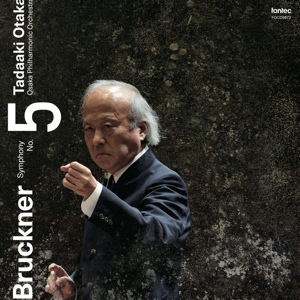
Anton Bruckner (1824-1896)
Symphony No. 5 in B-flat major, WAB 105 (ed. Nowak)
Osaka Philharmonic Orchestra/Tadaaki Otaka
rec. live, 14 February 2022, Suntory Hall, Tokyo
Fontec FOCD9873 [71]
My issues with previous recordings of Bruckner on the Fontec label by Otaka and the Osaka Philhamonic have been the conductor’s obtrusive vocalise, easily picked up by the microphones in a live performance, a preference for over-hasty speeds and perfunctory, even coarse, phrasing. These flaws are especially apparent in their recording of the Third Symphony; the Eighth, on the other hand, is not so materially vitiated and I was impressed by the sheer sound the orchestra makes.
This latest issue of the Fifth is decidedly on the fast side – nearly ten minutes faster than Karajan – and that difference is primarily attributable to the more than five minutes Otaka shaves off the Adagio and his finale being over three minutes shorter – nearly five minutes less than the finale of another of my favourite versions by Eichhorn. As ever, raw timings cannot tell anything like the whole story but they form a starting point for assessment, so I approached my first hearing of this warily. Of all Bruckner’s symphonies, the Fifth – along with the Eighth – is surely one which demands a grand, massive and, yes, “cosmic” approach; it is in some ways the most formidable of his works.
Certainly the opening is mightily impressive – and the rich sonority of that stately introduction is enhanced by the excellence of the recorded sound. The launching of the first Allegro theme is thrilling in its urgency but there is no sense of rush – but then Otaka’s vocal obbligato becomes clearly audible, especially in quieter passages. Perhaps others are less bothered by this and it is at first not continuous, only intermittent – but for repeated listening it is irksome, especially on headphones. He is mostly silent throughout the movement – a little light groaning notwithstanding – or else the music is so loud during the rest of this most unlikely of “sonata form” movements that its drama emerges intact, but every so often the listener will become all too aware of Otaka’s contribution. You might, however, be minded to forgive Barbirolli the same besetting bad habit in exchange for the intensity of the music-making and accord Otaka the same indulgence – and meanwhile, the orchestral playing is simply superb and the coda glorious.
The Adagio is for me more problematic. The basic tempo is positively brisk for a movement marked “Sehr langsam”. We are sold somewhat short on the requisite weird, otherworldly impression this music can generate in the right hands. Having said that, the second subject chorale is given its due – so what a pity we can hear Otaka loudly going “doo-doo-doo” along with the music – and that for me, kills this recording stone dead; who needs it? What a shame that such lovely playing should be so fatally marred. The Scherzo is just fine – driven and incisive but again Otaka lends it little percussive grunts and groans. Perhaps in a studio the sound engineers could and would demur – but this is live and I wonder how much the front row could hear – maybe only the microphones pick it up and as a result, we, are privy to his noises. The finale begins promisingly but – yes, you’ve guessed it – the conductor soon joins in and now, by eight minutes in, his vocalising is constant, masked only by the louder sections – and not always even then. In any case, the development section sounds rushed and substitutes speed for tension. I will not go on – but I am only sorry that such a potentially engaging performance should have been rendered unrecommendable.
All this makes for a frustrating experience, especially as the sound is first-rate and the audience silent – but there is no shortage of alternative accounts of this symphony which eschew its evident drawbacks.
Ralph Moore
(This review posted here by kind permission of The Bruckner Journal.)
Availability: HMV Japan

















